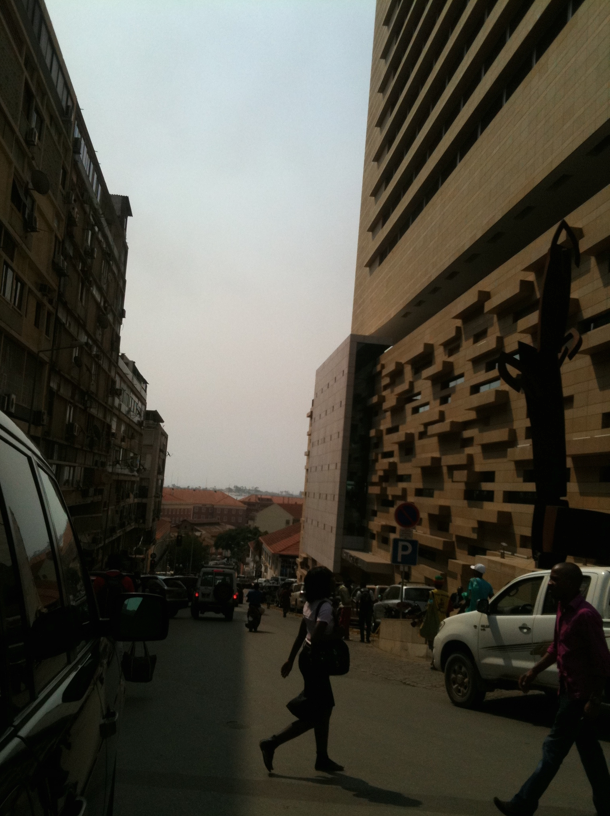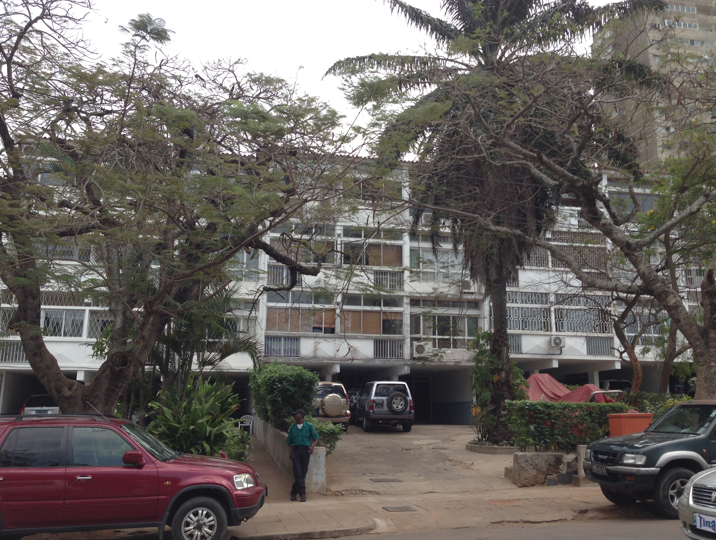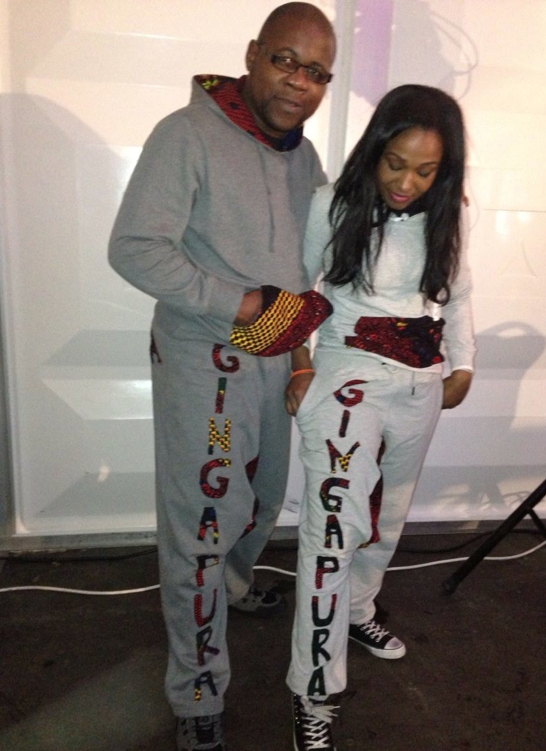On June 28th 2014, Mestre Petchu and his partner Vanessa ‘Ginga Pura’ Carvalo were in San Francisco, conducting a workshop of ‘kizomba, semba, and African tribal dance in the Bay area’. The photo advertising this event on facebook shows the two of them in typical semba pose, wearing outfits in which African fabric features prominently. Face markings in white paint are also visible on both dancers’ faces. The facebook event description states that ‘Dança Makèzú brings you Mr. Tarraxinha & Ms. Ginga, Mestre Petchu & Vanessa Pura Ginga of Angola, to the Bay Area!! Sass, funk, attitude, swagger, confidence, sweat, laughs are all part of learning, as Mestre Petchu and Vanessa lead us through a two-day fun-filled workshop full of kizomba, semba, and African tribal dance. This is not to be missed!!’ (nb: ‘tarraxinha: slow tempo Angolan couple dance; ginga: Portuguese; this term, originating in capoeira, can be translated as ‘swing’, with the added implication here of ‘sexy and dexterous movement of posterior’)
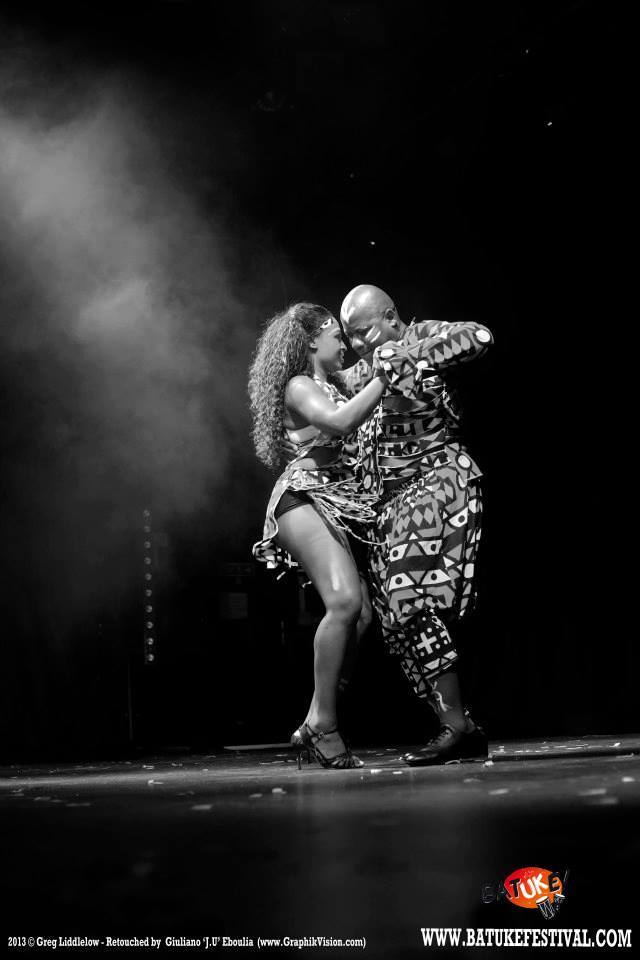
According to the schedule, each day concluded with an hour of ‘African tribal dance’. Unlike the kizomba and semba classes, these ‘tribal dance’ classes were not structured to reflect progression. The final version of the schedule also indicated that an attempt would be made to trace the ‘African tribal roots’ of semba. The dances ‘kizomba’ and ‘semba’ are recognized by social dancers of Afro-Latin style worldwide as having emerged from Angola. Likewise with ‘kuduro’, another widely recognized Angolan dance style (danced solo rather than in partner-hold). All three forms are strongly connected to the history, politics and identity discourse of colonial and postcolonial Angola. But what is this ‘African tribal dance’ that Petchu and Vanessa offered to Bay Area dancers? It seems that nobody really knew: a question I left on the event page- ‘Hi! Interested to know what the ‘African tribal dance’ class will be about?! Thanks!!’ – remained unanswered. The photos of the event now uploaded on the page show Petchu and Vanessa leading the class with physical movements broadly reminiscent of an African kinetic repertoire used when dancers are out of couple hold.
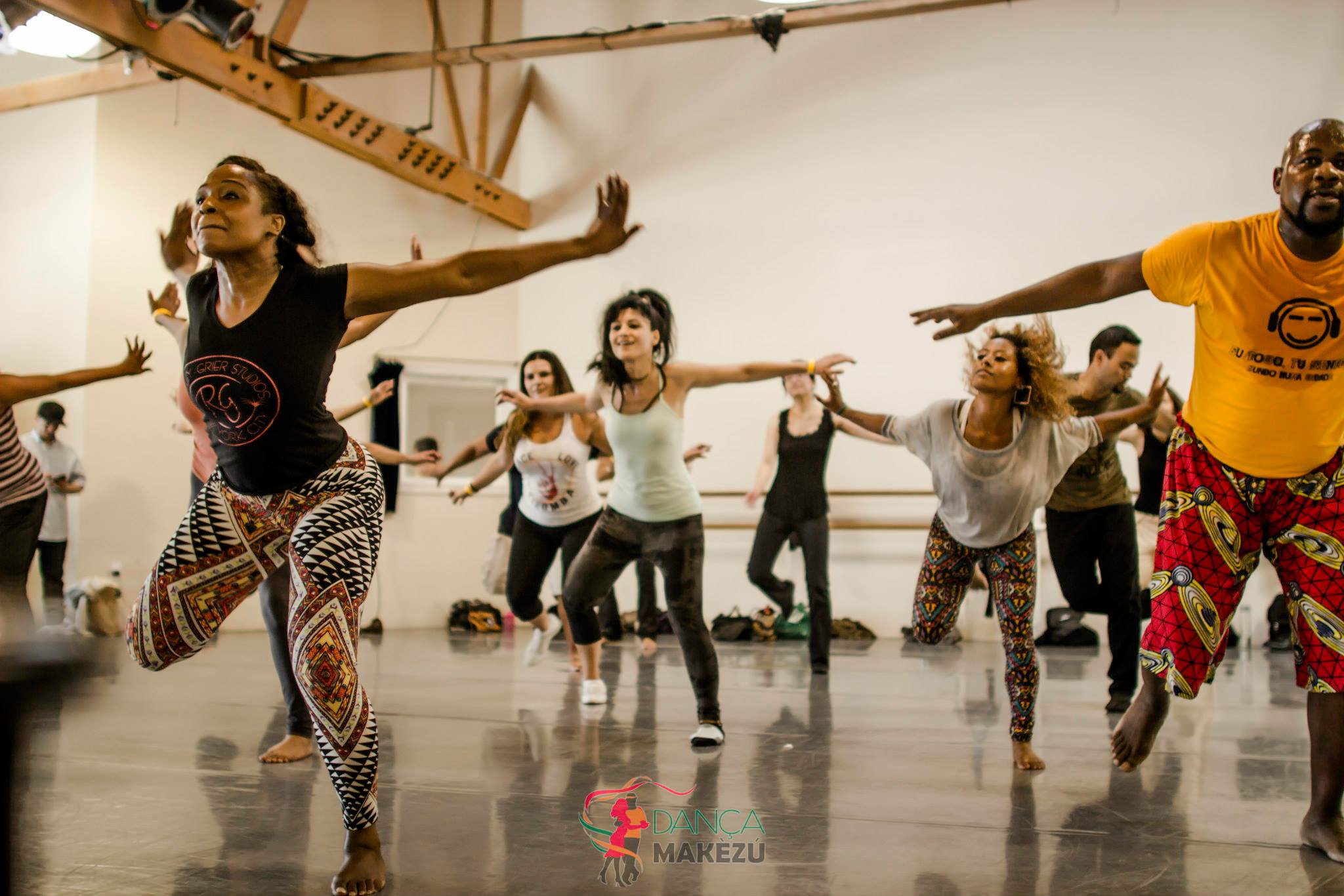
The Modern Moves research team has been intrigued by the word ‘tribal’ as used often by our postdoctoral associate Francesca Negro to report to us developments in the pedagogy of Angolan social dance. This is a word that, in both Anglophone and Francophone discursive contexts, is currently deployed with caution, and best within quotation marks, to signal a troubled semantic and ideological history. Postcolonial theory and colonial discourse analysis has flagged up the use of the category of the ‘tribal’ by all European imperial powers seeking to reduce Africa and other colonised regions (e.g. the South Pacific islands) to a stereotype of primitiveness and savagery. Even in Anthropology, the discipline fashioned around the study of ‘tribes’, the accepted term now would be ‘ethnic group’ or ‘ethnie’. Indeed in mainstream usage the adjective ‘tribal’ is most often seen in semantic contexts where the group described is anything but— e.g. a certain type of urban reveller, a particular sort of fashion choice, etc. It is usual amongst those who work in Africa to point with disdain and exasperation to comments from friends and family enquiring after the ‘tribes’ of Africa.
On querying Francesca about this puzzling use of ‘tribal’, it came to light that the phrase ‘African tribal dance’ in the Angolan context can be attributed almost certainly to one actor: Mestre Petchu himself. It is he who has popularised this term within Angolan dance pedagogy, and his most prominent students (e.g. Paulo Cruz) have generated its subsequent popularisations. The Mestre and his disciples have both defined and captured this part of the Afro/ Latin social dance market. Kizomba is now gaining popularity in the US through an axis of interpersonal connectivity that has brought its earliest American practitioners into contact with established ‘autocthonous’ leaders such as him. The concept of ‘African tribal dance’ is spreading precisely through this axis to neophyte, Anglophone, consumers across the Atlantic. The word ‘tribal’ is, in the process, constantly and progressively ‘re-normalised’ (at least for this group of users), the quotation marks silently being done away with.
After all, if a visibly ‘African’ person, a professional dancer in fact, uses the word ‘tribal’ to describe his dance practice, can the rest of us find it objectionable? I do not propose that we start berating Mestre Petchu for this (non politically correct) use of ‘tribal’; rather, I propose we use it as a point of entry into his psyche as a postcolonial Angolan person currently living in Portugal. Thinking harder about why he would use the word ‘tribal’ in this manner can, moreover, help us clarify our methodology as a research team in the face of some criticism from dance scholars that many of our activities that involve dance practitioners of African heritage succumb to ‘essentialism’ and ‘anti-intellectualism’. As a team, we acknowledge Mestre Petchu’s right to express a preference for the word ‘tribal’. Indeed, to analyse it as an example of what Gayatri Spivak first termed ‘strategic essentialism’ is more helpful for our overall research aim: to elucidate the intricate, often hidden relationships between dance, identity and the phantasm of ‘Africa’ for a spectrum of differently formed modern subjectivities.
Let me, at this point, quote from the following biographical notes on Petchu (Pedro Vieira Dias Tomas) and his partner Vanessa ‘Ginga Pura’ Carvalo. This information is supplied within the same facebook event page referred to earlier: ‘Mestre Petchu and Vanessa are one of the greatest world authorities in the field of Angolan culture of music and dance. Living in Portugal for many years now, Petchu was the first to teach kizomba and semba there. He is known to have spread kizomba, the dance, throughout Europe. Petchu is the founder of the African ballet group, Kilandukilu and has been leading this group for 25 years of his 30-year career. Vanessa, also a member of Kilandukilu, is [known] internationally for her Ginga, and is one of the best female Kizomba and Semba dancers in the world.’ While Petchu was born in Luanda in the 1960s, Vanessa is from Sao Tome e Principe. Their weekly classes at Studio Jazzy, Lisbon, conducted under the banner of Ballet Tradicional Kilandukilu, constitute one of that city’s many manifestations of Afro-Luso-postcoloniality. http://www.jazzy.pt/pt/about
This postcolonial Afro-Luso flavour of Lisbon is evident in its thorough permeation by dance and music from Portugal’s former African colonies. Downtown in the Baixa Chiado area, one can hear and see African groups playing live music on every street corner, while clubs lining the regenerated quayside play kizomba, semba and Cape Verdian dance forms alongside salsa and r n b. While Brazilian music is known and enjoyed, it is the visible, audible and kinetic presence of Portuguese-speaking Africans in Lisbon that makes Portugal seem an extension of PALOP Africa- as Mestre Petchu himself declared in a recent interview to the TV channel dedicated to the PALOP world, STPtv. In the same way, Luanda feels somehow very European, or at least it did so to me when I visited it a few years ago. I had to remind myself that the Portuguese presence in Africa was centuries older than the British presence in India. One has to really think of the concurrent movement into modernity of Lisbon and African cities of the Portuguese empire such as Luanda and Lourenco Marques (Maputo).
The evolution of creolized couple dances on the African mainland and Cape Verde, like those of the New World, brought together African dance repertoires and the frame of the couple hold (parallel syncretisms were taking place in the music). This evolution reveals long processes of cultural transfer, which would have indelibly transformed the valence of the ‘traditional’ in the realm of social dance and music. The conceptual framework here can draw from studies of colonial modernity and tradition(alism) in Africa and elsewhere (by Eric Hobsbawm and Terence Ranger, Dipesh Chakrabarty, Benedict Anderson, Partha Chatterjee, Achille Mbembe, Frederick Cooper). This work needs to be married to our ongoing work on excavating the complex evolution of the couple dances ‘kizomba’, ‘semba’ and ‘tarraxinha’ and of their accompanying music genres (the latter largely through contact with French Caribbean zouk music). Rather than go into those details here I want to signal that when Petchu uses the word ‘tribal’ he gestures, at least subconsciously, to the modern (read: ‘Europeanized’) forms of couple dances which have gained international prominence in post-Civil War Angola.
Angola’s double trauma of recovering from colonial rule, followed immediately by a prolonged Civil War, complicated immeasurably nation-building attempts after decolonization. These postcolonial processes must be seen on the micro-level of individual subjectivities as creating a yearning for an authenticity coupled with what Stefanie Alisch calls the ‘postcolonial schizophrenia’ binding together Portugal and its African ex-colonies. This contradictory psychosocial state may well be the reason why an Angolan such as Mestre Petchu can propagate couple dances with evident European genealogies on the one hand as ‘authentic Angolan dances’ as well as ‘African tribal dances’ comprising a repertoire of steps that are meant to transmit another kind of ‘authenticity’. It appears that by ‘tribal’, Mestre Petchu actually means ‘traditional’; Francesca explicated that he reserves the adjective ‘tribal’ for the actual nomenclature of the classes (whether he gives them in Lisbon or abroad), replacing it with ‘traditional’ in discussion with her and others. The Mestre’s interview with STPtv corroborates this statement but also nuances it in ways that confirms my hypothesis.
Within this interview, broadcast under the title ‘Amor e Danca’, 2nd June 2014, Mestre Petchu describes the work of his company, Ballet Tradicional Kilandukilu, through repeated use of the word ‘traditional’. Although he refers to breakdance and (non-specified) modern dance as examples of what they do not do, the major point of contrast is with the social dances kizomba and semba, which, all present at the interview agree, has been the door through which Angola has entered transnational dance. Kilandukilu, however, which means ‘enjoyment’ in Kimbundu, was formed in Luanda, in response to the needs of young people to return to their dance roots. These traditions demand the gravitas of pedagogy. They must be distinguished from kizomba, rather dismissively (but affectionately) described by interviewer and Mestre Petchu as the dance of the street (rua) and backyard (quintal). This understanding of Kilandukilu’s manifesto accords with Francesca’s explication that Petchu sees his ‘tribal dance’ classes as a way to ‘save’ steps but from other parts of Africa from ‘disappearing’– presumably due to a generalised modern malaise.
It is another matter that some of these dance steps and forms– for instance the sabar of Senegal and the khassonke of Mali– are neither purely ‘traditional’ forms (what, indeed, is?) nor in any need of rescuing. What is interesting is that an Angolan dancer based in Lisbon should see this rescue act as his mission. A certain kind of aspirational latter-day rough-and-ready pan-Africanism emerges through these attempts to forge an African tribal/ traditional dance style. A similar logic underlies Maxwell Xolani Rani’s creation of pedagogy for the B.A. in African Dance awarded by the University of Cape Town and taught at its once exclusive School of Dance that was renowned for Ballet. But Maxwell Xolani Rani has– thanks to the structure imposed on him by the needs to devise a university degree course, travelled through the African continent collecting steps and styles, whereas Mestre Petchu admits repeatedly in the STPtv interview that by Africa he really means ‘Angola’, which is what he knows best. I also doubt that UCT would use the word ‘tribal’ to describe the origins of these steps.
Bringing together these two points, we can deduce that Mestre Petchu’s adoption of the word ‘tribal’ occurs in the context of a self-confessed lacuna in detailed knowledge and a self-evident desire to invoke an idea of Africa that is greater than the nation he represents. This conglomeration is increasingly evident in the STPtv interview, where the word tribal first appears only two-thirds of the way into the 50-minute interview. Until that moment, Mestre Petchu has been using the word ‘traditional’ several times; he even corrects the interviewer’s use of ‘traditional African’ with a ‘parenthesis: by ‘African’ I mean 90 percent Angolan’. Only when describing the classes he conducts at Lisbon, he mentions that the class of traditional dance is called ‘tribal’. The interviewer picks this up, signalling through an exaggerated intonation the existence of quotation marks, ‘these “tribal” dances, these African dances- who are the foreigners who want to learn them?’ But even she is soon transfixed by the spell of the word– the next time she uses ‘tribal’ towards the end of the interview it is with a palpable note of pride- ‘our African tribal dances’.
It must be clarified here that the host of the STPtv show, Abigail Tiny Cosme, is from Sao Tome and Principe, and the channel’s raison d’etre is to promote art and culture in the wider PALOP world. So it is striking to see the speakers– Mestre Petchu and two female dancers of Kilandukilu, and Cosme herself– progressively bond over this idea of ‘us Africans’, with dance in our blood, with dance penetrating and shaping every activity of ours, even ostensibly sombre ones like funerals. ‘Africa is all the rage’, Cosme concludes the programme triumphantly while saying, and thanks Petchu for his work in bringing African culture, ‘our continent’, to the world. Given this desire to embrace rather than reject a (presumably) pre-modern communal corporeality as coded in the joy of movement and festivity, the idea of the ‘tribal’, proposed by Mestre Petchu and enthusiastically adopted by Cosme in course of the programme, makes quite a lot of sense. The Mestre’s use now seems a strategic attempt to re-articulate postcolonial schizophrenia into a viable and autonomous concept that has the added value of marking a distance from ‘non-tribal’ Europe.
It is one thing for a host from the archipelago of Sao Tome and Principe to go along with Mestre Petchu’s use of ‘tribal’ and ‘traditional’ in positing an overarching ‘Africa’ within whose kinetic regeneration all things Angolan are apparently playing a prominent part. What about representatives of other African nations– how would they feel about this capture of ‘Africa’ by Angola? This process of approximating ‘Africa’ to ‘Angola’ marks all scales and levels of the kizomba dance scene– most prominent being the dance competition and festival ‘Africadançar’ which started out eight years ago as a platform for a range of African social dances but now has become almost exclusively the showcase for Angolan forms– including Mestre Petchu’s version of ‘African tribal dance’. The organisers of Africadançar, being mostly from Portugal, are apparently not so concerned about the implications for the meaning of ‘Africa’ – their concerns appear far more pragmatic and commercial. In the meanwhile, individual actors enact the Afro-tribal’s dialogue with ‘modern’ in a postmodern-postcolonial way to reinterpret all the terms in the mix- ‘afro’, ‘tribal’, and ‘modern.’
Some other African practitioners of Angolan social dance appear as not too worked up about Angola’s strategic capture of ‘brand Africa’. Thus the Atlanta-based teacher of Angolan dance, Mwangi Maina, reveals in his facebook page and on his website that he is from ‘Kenya (Africa)’, where he grew up with music, and describes kizomba as an ‘African contemporary social dance’ with no mention of Angola at all. Here we see the de-Angolanisation of kizomba being manipulated to become useful for another African in diaspora to create a sense of self and identity through what the dance represents to him and to the world. As Mwangi Maina is one of the instructors gearing up to receive Petchu and Vanessa on their soon-to-begin US tour, it can be surmised that he does not see his act of self-definition vis-à-vis kizomba as intruding on his relationship with or respect for them. In the meanwhile the other promoters of this tour, who are organising the ‘African tribal dance class’ in San Francisco, are a dance couple consisting of a Latina woman (Chalianna) and a Haitian man (Yair).
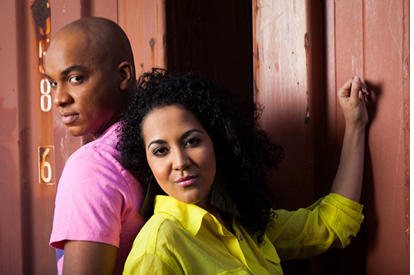
The ‘Afro-tribal’ via Angolan dance offers what Achille Mbembe calls African Modes Of Self Writing, and these are clearly also open to use within ‘Afro-diasporic modes of self-writing’. Mbembe concludes that essay with some suggestive comments about ‘stylizng’ in the process of ‘self-writing’. His term goes beyond Stephen Greenblatt’s influential earlier coinage, ‘self-fashioning’, returning decisively to the body as the ground of style (and fashion)—although Mbembe’s article itself proffers a philosophical rather than materialistic exploration of what we can call ‘self-styling’. In short, then, ‘Afro-tribal’ participates in acts of self-styling by people who wish to demonstrate ancestral connections to ‘African-ness’. It operates – not unproblematically– within the rebuilding of a post-diasporic, postcolonial self through bricolage, and it works best through a visual register. Face paint, animal skins, grass skirts, horn and bead jewellery, patterned textile, even spears and other ‘primitive weapons’, are thrown into the mix.
A fascinating supplement to this visualisation of the ‘Afro-tribal’ within dance is the use of ‘Afro-tribal’ by some DJs to label a particular kind of electronic music. In “>DJ Ras Sjamaan’s ‘Afro-Tribal’ mixes, rhythms typical of house and techno music are overlaid with sonic flashes of Africa to remind the listener what s/he is listening to. On a deeper level, dialogue between binary and ternary rhythms brings these mixes closer to the rhythmic logic of some kinds of African music. But less subtle references to Africa are established through human vocal items– voices, style of singing, chorus, shouts, often in non-European languages— and additional sounds produced by acoustic instruments– idiophones (bells, shakers…), drums. In case these descriptive sonic tags are not enough, geographical indications are liberally sprinkled throughout- such as shouts of ‘AFRICA’ and ‘ANGOLA’. A heightened version of this anxiety of recognition reappears in other examples of ‘Afro-tribal’ music, such as the ‘This Is Afrodelic’ series featuring tracks like ‘Afrika’, ‘Africa’, ‘Stereotype’, ‘From Apes to Humans’, ‘Tribal Work’ and, yes, ‘Tribal Ways’.
What work does the word ‘tribal’ do for these tracks? And what does it mean to ‘tag’ Africa — geographically as well as sonically — in them? These tags operate on a descriptive level within the tracks, and on a suggestive level paratextually. They insist on connecting the listener to a ‘afro’ and ‘Africa’, but coded as ‘tribal’. But who is the listener and where is s/he located? At home in front of a computer, or on a dance floor? If the latter, where in the world might this floor be? The mobility of music combines with music’s fundamentally abstract representational mode: if this track traveled out of Africa and onto another dance floor, who would know it originated in Africa? Did it, in fact?. We do not know where this track is composed, we do not know who assembled its YouTube pictoral version embellished with visual images of ‘Africa’. There is an anxiety of authenticity here—somehow the track’s value is augmented by its alignment to the African, where the African is ‘tribal’. It doesn’t matter if the Africa it references is the urban Africa of Afro-house music- as indicated by the debt of one of Ras Sjamaan’s mixes to ‘mete mete mete, não estou a sentir nada.’
Mestre Petchu’s use of Afro-tribal and house music’s use of ‘Afro-tribal’ seems to arrive at the same term through different routes, with rather different consequences for consumers (both African and non-African). While it is the black or brown body (especially, it seems, the male body) that participates in Afro-tribal self-styling through dress, the dance styles taught under this rubric are of course available to anyone who wants to embrace (for whatever purpose) their ‘inner African’, channelled— it would seem— through their inner ‘tribal’. However no one actually adopts that sort of costuming for party outfits. Inspiration for self-styling on the dance floor comes from fashions that are definitely Afro-modern, even Afro-Dandy– such as the style statements of Kizomba and Semba dancers, or the famous Congolese Sapeurs. In the realm of music, in contrast, we are less committed to changing our body style to declare our adherence to the ‘Afro-tribal’. The visual contrast between the typical world music aficionado and the AfroPolitan exhibiting swagger on the dance floor could not be starker.
Last week, examining the Afro-tribal against a reading of Mbembe’s essay (‘Modes of African Self-Writing’), the Modern Moves team was led to reconsider our own embodied relationships to Africa. Discussing our tattoos, hair braids, African saris and –even in one case—the decision not to overtly self-style after African style, took us back to our earliest years, the roots of our intellectual formation, the foundations of our curiosity about that which is not ‘us’. While we are still thinking about the range embedded in ‘Afro-tribal’, this self-examination suggested how we may take further Achille’s concluding observation: ‘Because the time we live in is fundamentally fractured, the very project of an essentialist or sacrificial recovery of the self is, by definition, doomed. Only the disparate, and often intersecting, practices through which Africans stylize their conduct and life can account for the thickness of which the African present is made.’ Not just the African present, then, but a planetary present through which ‘Africa’ and Africa traverse.
This Moving Story was written by Ananya Kabir, with generous inputs from Elina Djebbari, Francesca Negro, and Madison Moore. Its concepts and arguments have been developed during the Modern Moves team’s weekly conversations.
All photos by Ananya Kabir unless otherwise noted.


